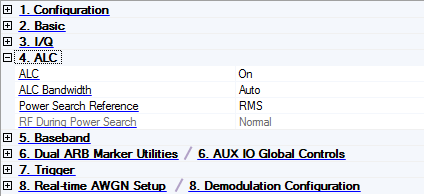4. ALC

M9381A/M9383A

M9383B VXG-m and M9384B VXG

ALC Auto
(M9383B/M9384B only)
Choice: On | Off
Default: On
Enables or disables ALC On and ALC Bandwidth couplings.
For IQ modulation, ALC Auto and Power Search Auto should be On.
ALC
Choice: On | Off
Default: On
Double-click or use the drop-down menu to enable or disable the automatic level control.
On – The ALC circuit constantly monitors and controls the output power level.
Off – No automatic leveling occurs.
ALC Trigger Source Bus
(M9381A
Choice: AUTO | PXI0 | ... | PXI7
Default: AUTO
Double-click or use the drop-down menu to select a bus for ALC hold signal path on PXI backplane.
ALC Hold Mode
(M9381A
Choice: Off | Track on Marker | Hold on Marker
Default: Track on Marker
Double-click or use the drop-down menu to select how the ALC circuit in the output module functions when the ALC is enabled. ▪ Off − ALC hold is turned off. ▪ Track on Marker − When playing a waveform file and a Marker is crossed in the waveform file, the ALC will track on the Marker. ▪ Hold on Marker − When playing a waveform file and a Marker is crossed in the waveform file, the ALC will hold on that Marker.
ALC Bandwidth
Choices: Auto | 200 Hz | 2 kHz | 20 kHz
Default: Auto
Double-click or use the drop-down menu to select the ALC loop bandwidth. Choose Auto to let the signal generator automatically select the optimized bandwidth for the current signal setup.
This parameter is not available for all instrument model numbers and may be grayed out.
ALC Bandwidth
(Applies to M9383B VXG-m and M9384B VXG only)
Choices: Very Slow | Slow | Medium | Fast
Default: Very Slow
Sets the detector feedback loop bandwidth depending on the modulation type running on the system to reach the requested absolute output power requested. Very narrow loop bandwidths (Very Slow) causes the leveling loop to pass rapidly changing amplitude levels, but still corrects for slow amplitude drift due to temperature variations or other effects over longer durations of time. Slow or Medium increases the loop bandwidth to partially correct/level for rapidly changing amplitude fluctuations. Fast increases the loop bandwidth provide rapid correction of or rapidly changing amplitude fluctuations. For IQ modulation the ALC & Power Search should always be set to Auto.
Very Slow – use for CW or modulation with low rate amplitude variation
Slow or Medium – use for CW or modulation without amplitude variation
Fast – use for CW, FM and pulse operation
Power Search Reference
Choice: RMS | Fixed | Manual | Modulated
Default: RMS
Double-click or use the drop-down menu to select a fixed or modulation reference signal when doing a power search.
-
RMS − power search uses DC bias that is equivalent to the value derived from the file header or the calculated value from the current I/Q data.
-
Fixed − power search uses a fixed DC bias value.
-
Manual− power search allows the user to specify the DC bias voltage.
-
Modulated − power search uses the AC bias from the actual modulating signal.
Set ALC to Off to enable this parameter.
RF During Power Search
Choice: Normal | Minimum
Default: Normal
Double-click or use the drop-down menu to select the level of the output power control during a power search routine.
-
Normal – Performs power searches without setting the internal step attenuator to its maximum setting. Glitches and power changes may be present during the search.
-
Minimum – Sets the signal generator's step attenuator to its maximum setting during power search to protect sensitive circuits.
Set ALC to Off to enable this parameter.
Power Search Auto
(M9383B/M9384B only)
Choice: On | Off
Default: On
Toggles Power Search Mode between On or Off.
When enabled, power search calibration routine is executed whenever an instrument setting is modified. This includes changes to frequency, amplitude and modulation.
For IQ modulation, ALC Auto and Power Search Auto should be On.
For M9383B/M9384B, this parameter is grayed out and set to Very Slow when ALC Auto is On.